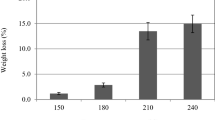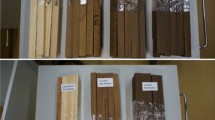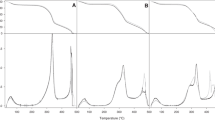Abstract
In timber drying, mechanical properties may be changed due to treatment temperature and treatment duration. In general, when increasing the kiln temperature, drying time is decreased and some timber properties are negatively affected. In this study, the effect of different drying temperatures (80, 120 and 170 °C) on equilibrium moisture content and sorption rate, on bending strength and stiffness was investigated for Norway spruce and larch from four proveniences and the results were compared to those obtained for heat-treated wood (Thermowood
®). The experiments confirm earlier research that both treatment temperature and treatment duration affect the properties. High-temperature drying or treatment can be optimized for several applications, yielding strong but not so durable timber or vice versa.
Zusammenfassung
Bei der Holztrocknung können Änderungen der Holzeigenschaften aufgrund von Behandlungstemperatur und -dauer auftreten. Erhöhte Trocknungstemperaturen führen im Allgemeinen zu einer Verkürzung der Trockendauer und einer negativen Beeinflussung einiger Eigenschaften. Die vorliegende Studie behandelt die Auswirkung unterschiedlicher Trocknungstemperaturen (80, 120 und 170 °C) auf Gleichgewichtsfeuchte, Sorptionsrate, Biegefestigkeit und -steifigkeit in Fichte und Lärche unterschiedlicher Herkunft und vergleicht diese Ergebnisse mit denen von wärmebehandeltem Holz (Thermowood
®). Die Versuche bestätigen die Ergebnisse früherer Untersuchungen in der Hinsicht, dass sowohl Trocknungstemperatur als auch Trocknungsdauer die Holzeigenschaften beeinflussen. Hochtemperaturtrocknung oder Wärmebehandlung kann für unterschiedliche Anwendungszwecke optimiert werden, um Holz mit hoher Festigkeit und weniger guter Dauerhaftigkeit oder umgekehrt zu produzieren.
Similar content being viewed by others
References
Bekhta P, Niemz P (2003) Effect of High Temperature on Change in Color, Dimensional Stability and Mechanical Properties of Spruce. Holzforschung 57(5):539–546
DIN 52186-1978: Prüfung von Holz; Biegeversuch (conforming with ISO 3133-1975 ‘‘Wood – Determination of ultimate strength in static bending’’)
Frühwald E (2007) High-temperature drying of Norway Spruce with and without restraint: Effect on twist. Dry Technol 25(6)
Gerhards CC (1979) Effect of high-temperature drying on tensile strength of douglas fir 2 by 4’s. For Prod J 29(3):39–46
Gerhards CC (1983) Effect of high-temperature drying on bending strength of yellow-poplar 2 by 4’s. For Prod J 33(2):61–67
ISO 3131-1975: Wood – Determination of density for physical and mechanical tests
Jämsä S, Viitaniemi P (2001) Heat treatment of wood – Better durability without chemicals. Proceedings of COST E22 Special Seminar, Antibes, France, 2001-02-09, edited by Rapp AO: 21–26
Koch P, Wellford WLJ (1977) Some mechanical properties of small specimens cut from 1.79-inch-thick southern pine dried for 6 hours at 300 ° F or for 5 days at 180 ° F – a comparison. Wood Fiber Sci 8(4):235–240
Kubojima Y, Okano T, Masamitsu O (2000) Bending strength and toughness of heat-treated wood. J Wood Sci 46(1):8–15
McNaught AM, Gough DK (1995) Drying 40-mm-thick slash pine in 2.5 hours at 200 °C. For Prod J 45(1):51–54
Schneider A (1973) Investigations on the convection drying of lumber at extremely high temperatures. Part 2: Drying degrade, changes in sorption, colour, and strength of pine sapwood and beechwood at drying temperatures from 110 °C to 180 °C (in German). Holz Roh- Werkst 31(5):198–206
Sehlstedt-Persson M (1995) High-temperature drying of Scots pine. A comparison between HT- and LT-drying. Holz Roh- Werkst 53:95–99
Syrjänen T (2001) Production and classification of heat treated wood in Finland. Proceedings of COST E22 Special Seminar, Antibes, France, 2001-02-09, edited by Rapp AO: 11–19
Terziev N, Daniel G (2002) Industrial kiln drying and its effect on microstructure, impregnation and properties of Scots pine timber impregnated for above ground use – Part 2. Effect of drying on microstructure and some mechanical properties of Scots pine wood. Holzforschung 56(4):434–439
Thiam M, Milota MR, Leichti RJ (2002) Effect of high-temperature drying on bending and shear strengths of western hemlock lumber. For Prod J 52(4):64–68
Time B (2002) Studies on hygroscopic moisture transport in Norway spruce (Picea abies). Part 1: Sorption measurements of spruce exposed to cyclic step changes in relative humidity. Holz Roh- Werkst 60(4):271–276
Yao J (1979) Effect of High-Temperature Drying on the Strength of Southern Pine Dimension Lumber. For Prod J 29(8):49–51
Author information
Authors and Affiliations
Corresponding author
Rights and permissions
About this article
Cite this article
Frühwald, E. Effect of high-temperature drying on properties of Norway spruce and larch . Holz Roh Werkst 65, 411–418 (2007). https://doi.org/10.1007/s00107-007-0174-8
Published:
Issue Date:
DOI: https://doi.org/10.1007/s00107-007-0174-8




